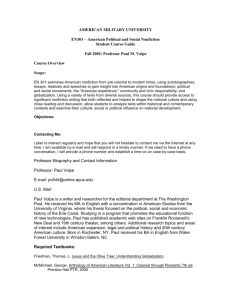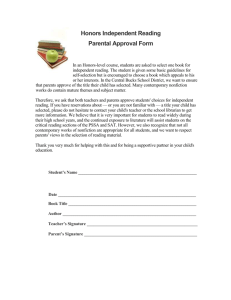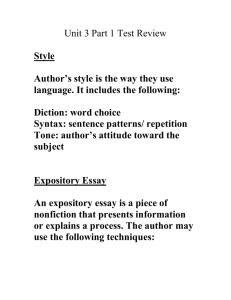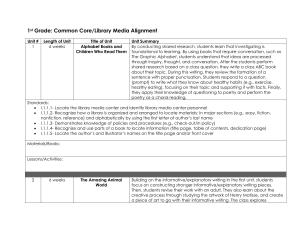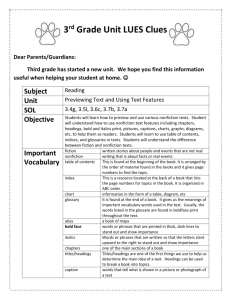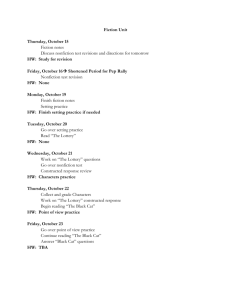in the unit? - Pittsburgh Public Schools
advertisement
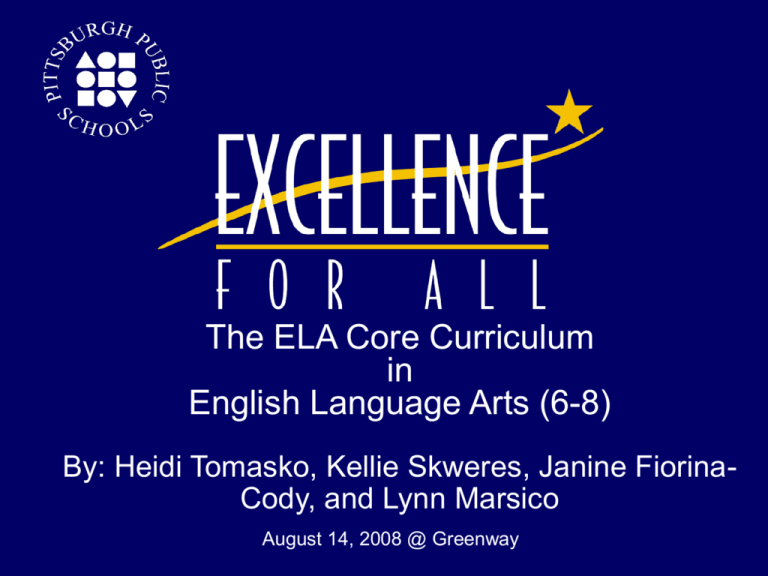
The ELA Core Curriculum in English Language Arts (6-8) By: Heidi Tomasko, Kellie Skweres, Janine FiorinaCody, and Lynn Marsico August 14, 2008 @ Greenway Strategies for Academic Achievement (PART 1) 1. Evaluate all programs for effectiveness and replace where necessary 2.. Provide a rigorous curriculum aligned to state standards, assessments, and instruction 3. Provide ongoing professional development for all teachers and staff focused on academic objectives 4. Create a “Pittsburgh Leadership Academy” to provide professional development for principals and central staff 5. Implement a district-wide coaching model 6. Establish Accelerated Learning Academies 7. Create individual school improvement plans with specific academic achievement goals 8. Adopt a writing program across the curricula 9. Develop a high school reform model that includes: Redesign Career & Technical programs Expand and increase participation in Advanced Placement, International Baccalaureate, Center for Advanced Studies, and dual enrollment courses Continued partnership with universities Objectives Explain the instructional practices that occur within the ELA Core Curriculum. Define the term Culturally Responsive and how it impacts our Core Curriculum. Review Roadmap changes and the rationale behind those changes. Create a graphic representation of each unit by grade level. Anticipate what opportunities exist within these units to promote student engagement. Discuss what struggles and successes students may experience in these units. Reflect as a teacher and as a learner on the DL lessons in the upcoming 6th, 7th, and 8th grade units. Become familiar with the Teaching and Learning Feedback Tool Culturally Responsive Curriculum in English Language Arts: Seeing our students’ cultural backgrounds as supports for learning rather than deficits Acknowledging and building from students’ personal, ethnic, class, gender, neighborhood, and school histories to promote learning Choice of Texts Students studying the Core Curriculum in English language arts will spend a considerable amount of time studying works by a wide-range of writers representing a variety of experiences, e.g., African American, women, economically disadvantaged, etc. Every effort is being made to include as many Pittsburgh writers as possible. Units designed around texts that are more accessible to increasingly difficult (e.g., “The Treasure of Lemon Brown” to “Harriett Tubman”). Where texts deal with topics that might be previously unknown, activities are designed to support broadening students’ knowledge base (e.g., mini-/full research units on the Holocaust or Apartheid). Design Features of the Units Gives multiple opportunities for students to say what they already know Gives multiple opportunities for students to link big ideas of texts and units to their personal experiences Works to identify in advance issues or content that might not easily be accessible to students or that might be emotionally charged Gives multiple opportunities for students to say how they learned (increase chances of transference) Gives multiple opportunities to make sense of texts independently and with peers Gives variety of ways students can engage with learning and demonstrate their understanding. Building Intellectual Community in Classrooms High expectations in the Core Curriculum are reflected in the requirement that all students inquire, investigate, read, write, reason and talk about critical questions, problems, and concepts. Teachers use scaffolding (inquiry, direct instruction, modeling and observing, differentiation, guided reflection) to ensure that students of all backgrounds do the intellectual work involved in understanding the core content. Multiple Perspectives Encouragement of the use of multiple perspectives occurs through providing opportunities for students to reflect on their learning as they learn from each other. Students are consistently exposed to the different perspectives of their peers through pairing, small group, and whole group discussions. Charting of these thoughts and feelings is a means of validating what viewpoints students bring to the classroom and maintains these viewpoints as a reference. Students are also invited to take on the perspectives of the characters in and the authors of the multicultural texts from which they are learning. Texts selected to reflect the perspectives of various writers from different cultural backgrounds enable students to not only see themselves in the literature but also become sensitive to the many commonalities that all cultures share. Student Engagement Student engagement is on-going through the presentation of unit questions which drive the overarching questions that are the power of purpose and motivation for the learning taking place in each unit. These questions are grounded in inquiry and are designed to be open ended which allows all students to approach these questions from multiple perspectives that are both personal and text-based. A compilation of ideas and reactions in the Reader’s/Writer’s notebook is a means of engaging students as they document their learning experiences in their own words. Assessment The learning potentials of students are assessed through several formative assessments. Students can demonstrate their learning at entry points that are at varying comfort levels: pair/share, trio/share, small group discussions, entries made in Reader’s/Writer’s notebooks. Differentiation strategies and interventions are able to be employed if these formative assessments reveal a need for students who are struggling with particular concepts. Not being chained to one form of assessing students’ learning is another way of responding to the various learning styles and needs of students from various backgrounds. Roadmap Revisions 2008-2009 School Year Road Map Revisions were informed by: Feedback from teachers, ITLs coaches and administrators Data from 4Sight and Core Curriculum Benchmarks The need to align each curriculum to all elements of the Pennsylvania State Standards and Eligible Content The need to incorporate more vocabulary and grammar instruction into the established DL pattern The charge to create a more culturally responsive curriculum Changes that Apply to All Grades More time and attention will be devoted to nonfiction, vocabulary, grammar and writing instruction. A novel or unit has been removed, at most grade levels, to allow time for more explicit writing instruction. Students will receive the majority of their grammar and vocabulary instruction in the context of their reading and writing. Grammar and mechanics will also be addressed through mini lessons based upon formative assessment of students’ needs. Portfolio – Portfolio requirements will be marked in the Road Maps and in the units. Differentiated Instruction – We will add more options/ suggestions for differentiation. Differentiation of process and product need to be addressed. Learning styles should be considered when differentiating assignments. Roadmaps were aligned with the DWA so that instruction will occur in the Core between pre and post tests. Grade 6 Road Map for 2008-09 Grade 6 Previous Units Proposed Units Unit One Selected Works of Fiction and Nonfiction Unit One Selected Fiction, Nonfiction, Functional Documents (interviews and biographical text), and Poetry Unit Two I Thought My Soul Would Rise and Fly Unit Two On My Honor Unit Three Selected Works of Fiction and Nonfiction Unit Three Selected Poetry (New Unit) Unit Four Bud, Not Buddy Unit Four Selected Nonfiction and Researched Sources on Great Depression Unit Five Selected Works of Fiction and Nonfiction Unit Five Bud, Not Buddy Unit Six Holes Unit Six I Thought My Soul Would Rise and Fly Unit Seven Selected Works of Fiction and Nonfiction Unit Seven PSSA Reading Practice Module; Selected Works of Fiction, Nonfiction and Poetry Unit Eight On My Honor Unit Eight Holes Unit Nine Selected Works of Fiction and Nonfiction Unit Nine Selected Nonfiction (published and student models of Reflective Essays and Memoir) Grade 7 Road Map for 2008-09 Grade 7 Previous Units Proposed Units Unit One Selected Works of Fiction and Nonfiction Unit One Selected Nonfiction: Biography and Autobiography Unit Two Hatchet Unit Two Tangerine Unit Three Selected Poetry Unit Three Selected Nonfiction and Research Sources Unit Four The Giver Unit Four Selected Nonfiction Unit Five Selected Advertisements Unit Five Roll of Thunder, Hear My Cry Unit Six Tangerine Unit Six Selected Poetry Unit Seven Selected folktales, myths, legends, autobiographies, and biographies Unit Seven Selected texts; PSSA Release Tasks in Preparation of PSSA Reading Unit Eight Roll of Thunder, Hear My Cry Unit Eight The Giver and Among the Hidden Unit Nine Various Research Sources Unit Nine “The Monsters are Due on Maple Street” Grade 8 Road Map for 2008-09 Grade 8 Previous Units Proposed Units Unit One Selected Works Unit One Student Models, “About the Author” selections from Holt Unit Two Among The Hidden Unit Two Out of the Dust; Selected Poetry Unit Three “Flowers for Algernon” and “The Diary of Anne Frank” Unit Three Expository Texts used for Research Unit Four Chain of Fire Unit Four Unit Five Chain of Fire PSSA Writing Readiness Unit Unit Five Selected Works Unit Six Selected Speeches: “I Have a Dream,” “The Gettysburg Address,” “The First Americans,” “Slavery,” “What to the Slave is the 4th of July?” Unit Six Out of the Dust Unit Seven PSSA Reading Readiness Unit Unit Seven Selected Works Unit Eight Selected Short Narratives: “Mrs. Flowers,” “from Harriet Tubman: Conductor of the Underground Railroad,” “The Treasure of Lemon Brown,” “Ribbons” Unit Eight Whirligig Unit Nine Whirligig Unit Nine Selected Works Unit Ten “Flowers for Algernon” and “The Diary of Anne Frank” Relighting The Fire Reconnecting Effort and Success through the Core Curriculum My Appointments Draw a clock face on a piece of paper Indicate 12, 3, 6, and 9:00 Take 3 minutes to make mutual appointments for each of these times Return to your original seats Access Prior Knowledge Quick Write: Take 2-3 minutes to respond to the following on the paper provided: What are some things that you, or people you know, have quit trying to learn? When time is called go to your 12:00 appointment and share your response. In your appointment collaborate to answer this: What are some common factors that contribute to quitting? Cycle of Failure Failure Loss of Self-Esteem Frustration Loss of Motivation Avoidance Lack of Practice LEARNED HELPLESSNESS Picture a student from your past. What did his/her learned helplessness look like? The Matthew Effect: The Rich Get Richer and The Poor Get Poorer What Can We Do To Interrupt This Cycle? Most of us have witnessed the phenomena of a student reawakening to learning. QuickWrite: Think of a student (if you can) who made a turn-around. Describe what you believe to have been the factor(s) that moved this child out of the Failure Cycle. Go to your 3:00 appointment and share your analysis. Decide together whether these motivating factors occurred accidentally or were planned and intentional. Organizing for Effort Repetition of a Learning Pattern Artifacts to make thinking visual Readers/Writers Notebook to track thinking and work Explicit back mapping of Culminating Projects Student created protocols organize discussions Clear Expectations Posting of Overarching and Unit Questions for refocusing and retrospection of the learning purpose. Artifacts provide written rather than oral prompts and assignments and opportunities to recall the progress of the work and thinking. Teacher modeling of any new skill or learning activity Ongoing use of student models to guide learning as it approximates the expectation Fair and Credible Evaluation In progress work and learning in Reader’s Writer’s Notebook and homework assignments are evaluated according to effort rather than the quality of a “final” product. Summative Assessments such as Process Writing and Culminating Projects are apprenticed and scaffolded through models and back mapped through modules to support success. As units are revised, Culminating Projects will provide more variety in the way a skill can be assessed and the products for assessment. Student choice will increase. Recognition of Accomplishment Multiple informal opportunities for teacher encouragement and private praise are available during “over the shoulder” work. Encouragement and praise delivered through notes in the R/W Notebook can occur weekly or daily for students in need of extra and/or private support. Daily work with peers (governed by shared protocols) provides opportunities for praise, recognition and support by those who sometimes matter most, their peers. Classroom Artifacts that reflect student responses, work and ideas provide ongoing recognition of the value of the students’ ideas. Many units end with suggestions for celebrations of accomplishment. Academic Rigor in a Thinking Curriculum The curriculum is explicitly designed to set very rigorous learning goals with abundant scaffolding to support students along multiple learning paths. Unless the teacher is modeling, the challenging work of interpretation, analysis, and evaluation, the thinking work, is done by students and supported by the teacher. Learning outcomes are focused on developing the essential content and habits of thinking that are central to the discipline. These habits are taught explicitly and ritualized. Accountable Talk Paired, small and whole group discussions are a daily part of the curriculum and essential to the instructional pathway. Students collaborate to create a set of protocols to guide their interaction during discussion. This allows for student ownership and self-management. Talk makes thinking public and so provides authentic peer models to scaffold higher level thinking. Talk provides an opportunity for auditory and verbal learners to participate and develop core skills that they may not have been able to through reading and writing alone. Visual learners benefit from charting. Socializing Intelligence Students see that intelligence is not static! Intelligence grows through effort. Beginning with prior knowledge provides multiple entry points so that all students can engage from the start of a lesson. Effort is increased in a safe, supportive environment where risks can be taken and peers of differing abilities and perspectives are all challenged to take these risks. The curriculum provides daily opportunities for interaction with peers who learn and think within a wide ability range. Teachers may support this process by grouping students with complementary strengths. Recognition and validation of multiple perspectives during class discussion supports socializing intelligence as well as culturally responsive instruction. Self-Management of Learning The Reader’s / Writer’s Notebook is the central tool for self-management. The teacher can support this with artifacts for organizing this tool. StepBacks and Retrospectives (Metacognition) provide opportunities for students to reflect upon their own learning processes both old and new and identify strategies that may work in new situations (transfer). Classroom protocols for discussion and class created criteria support a self-managing community of learners that is student centered. Learning as Apprenticeship Teachers are encouraged to create authentic models during all learning activities. Scaffolds should be systematically removed for students, and made optional and available, as students individually progress in their ability. This differentiates the learning continually. As students progress in their skills, the teacher’s role becomes more and more of a support or facilitator to the work. Location, Location, Location Take time with your 6:00 appointment to locate one example of the Principals of Learning in your own units. Be prepared to share your findings. Overview of the ELA Core Curriculum: 6th-8th Grade Accessing Prior Knowledge What are the key components of a DL unit? Write your responses individually; be prepared to share them with the group. Getting the Gist of it… The Big Picture: Review your assigned unit with the people at your table. As you read, consider the following: If you could represent this unit graphically (as a picture), how would it look? Record your representations on chart paper. Be prepared to share your work and to justify the graphic you chose. Let’s Discuss… • Choose a presenter for your group: -Why did you choose to “represent” your unit in the way that you did? -What “Ahas” occurred as you engaged in this work? StepBack: Quick Write Reflect on this activity as a teacher… What similarities/differences do you notice across these units? How did engaging in this activity help prepare you to teach this unit? Prepare to share your response with a partner/the whole group. Lunch Time! Review of Grade Level Units Revisit more closely the grade-level unit you’ve been assigned. Read through it independently one module at a time. As you read, consider the following talking points: What CE’s/PE’s and Eligible Content are addressed? What mini-lessons could you create for use during Writers’ Workshop that align with the writing genre in your unit? What trouble spots/successes do you anticipate? Where do you see natural places to build in differentiation? What scaffolding do you feel is needed? What planning/prep is involved? What are your “favorite moments” in the unit? The ELA Teaching and Learning Feedback Tool Please turn to page 55 of the English 6-12 Handbook to view to ELA Teaching and Learning Feedback Tool. Use of the Tool This tool will be used during classroom visitations and learning walks. The intent is to provide feedback to inform the professional development training. This tool is not to be used in evaluative ways. This tool supports the recursive cycle of professional development and professional learning of teachers. English Content and Context p. 55 What unit are the students working on? What text/s are the students working with? What part of the pattern are the students engaged in? (Gist, significance, etc.) What overarching questions and concepts are students working to understand? Is the task/question being used as it is written in the curriculum? Are the students and teacher working on literary concepts using reading, writing, speaking and listening with an inquiry stance? Potential for Student Progression from Comprehension to Critical Thinking p. 55 Is the task set up so that the students are making sense of the text from literal comprehension to critical thinking through talking, writing and working with others? Are students working towards producing extended writing assignments that demonstrate their understanding of whole texts and major discipline-specific questions? Are students given multiple opportunities to engage in the writing process? Academic Rigor in a Thinking Curriculum pp. 56 - 58 Do students engage in active thinking, talking and writing about challenging ideas and texts? Tool is divided into three sections: 1. Students’ Active Use of Knowledge 2. Evidence/Observations 3. Teacher’s Implementation of Task Academic Rigor in a Thinking Curriculum - Example Inquiry Discussion – Students’ Active Use of Knowledge 1. Are students given the opportunity to engage in whole group inquiry discussion where the emphasis is on how the group talk is deepening everyone’s understanding of the text ideas, the quality of the students’ interpretations, and socialization into the linguistic and literary routines of the discussion? 2. Is the focus question one that has more than one plausible response supportable with evidence from the text? Academic Rigor in a Thinking Curriculum - Example Inquiry Discussion – Teacher’s Implementation of Task 1. How does the teacher set clear expectations for students’ roles during the discussion? 2. What evidence is there that the teacher shows students how to engage in discussions through follow-up questions, requests for clarification, prompting connections to text, assisting connection-making between knowledge and text, and bringing students back to the guiding questions? 3. How does the teacher use wait time? 4. How does the teacher encourage all students to engage in the discussion? 5. How does the teacher press for elaboration of responses or more appropriate evidence? Accountable Talk p. 59 In what ways do students talk about English language arts content and share their thinking? The tool is divided into three categories for this section: 1. Student Talk 2. Evidence 3. Teacher Talk Accountable Talk - Example Student Talk: In what ways did student-to-student discussions occur during the lesson? What evidence exists that students have learned to support each other’s learning? Teacher Talk: In what ways did the teacher facilitate a discussion with and among students? Classroom Environment – Physical and Social p. 60 In what ways does the classroom environment support high level work, student exploration and discussion of texts and concepts? A. In what ways are the following made public (through display or other means), discussed, and used by students? B. How is the physical environment of the classroom conducive to learning in English language arts? C. What type of feedback is provided on student work and how does the written feedback help students to advance their learning of concepts and make connections between their own work and the criteria for quality work? It’s 9 o’clock! Please discuss the following quote with your 9 o’clock appointment: Learning and teaching should not stand on opposite banks and just watch the river flow by; instead, they should embark together on a journey down the water. Through an active, reciprocal exchange, teaching can strengthen learning how to learn. Loris Malaguzzi How does this quote relate to the curriculum work in Pittsburgh? StepBack: Reflect on Learning How has our work today helped you to better understand the Core Curriculum/DL Pattern? Final Thoughts… Any questions, comments, or concerns?


